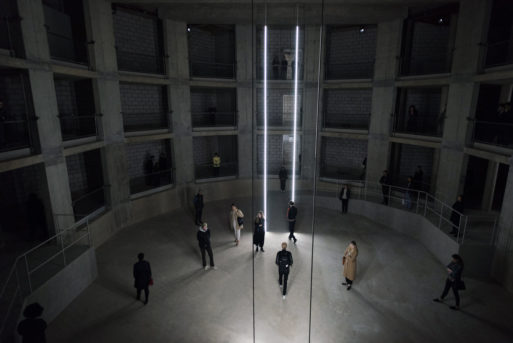
Credit: artrabbit.com
In September 2016, an installation opened at the Armory Arts Center in New York that explored the cultural multiplicities of grief as expressed in different countries, from Ecuador to Ghana to Burkina Faso to Cambodia. For the installation, “An Occupation of Loss,” artist Taryn Simon brought together professional mourners from 15 different countries to broadcast their grief to the gathered audience. Many of the professional mourners hailed from families in which the art of mourning had been passed down through many generations.
Visitors entered the the venue through a fire escape and walked onto a balcony overlooking a vast space populated by 11 tall concrete towers arranged in a semi-circle. As mourners emerged from the darkness and filed into each of the towers, the visitors descended the stairs as the mourners began to vocalize their lamentations. The voices rose in a cacophonous wail and then fell away to a single voice and finally lapsed into a deep meditative silence. “I have heard this kind of mourning referred to as melodicised speech and also as tuneful weeping,” Simon said after the performance. “It can sound like music, but it is not music. It is a heightened expression of loss that comes from a place beyond words, beyond language, a purely sonic experience.”
In one tower, a blind Ecuadorian mourner played the accordion and passionately sang. For the last 40 years, he has played four or five funerals a day.

Credit: architecturaldigest.com
In another tower, a woman from Ghana wept while she sang, then turned it off abruptly and composed herself with a level of mastery over her emotional expression that revealed her highly developed skill as a performer.
While there is nothing quite so raw as the experience of grief for families and friends, professional mourners are paid to express the grief. “For the audience to think about how something that seems so pure and private is being shaped and performed scrambles everything,” Simon explains. The piece explores that tension, and viewers are prodded to confront their own feelings about the intense emotional expression being displayed without any explicit implied reason: The mourners aren’t mourning anyone in particular.
Simon spent seven years developing “An Occupation of Loss.” Four of those years were spent collecting affidavits and references from anthropologists and academics in order to secure visas for the performers. Some visas required repeated attempts. It was an experience fraught with uncertainty and frustration.
“An Occupation of Loss” throws into relief Western expressions of collective mourning, which are controlled and shaped by institutions and ideology to prevent disruptive expressions of raw emotion. Speaking on the Parkland school shooting in Florida, Simon says, “There was not a unified voice of loss, so the children had to step into that space.”

 An Occupation of Loss: Installation Featuring Professional Mourners From Around the World
An Occupation of Loss: Installation Featuring Professional Mourners From Around the World


 Recovering Cremation Remains After the Los Angeles Fires
Recovering Cremation Remains After the Los Angeles Fires
 “As Tears Go By” by Marianne Faithfull
“As Tears Go By” by Marianne Faithfull
 “The Sea” by John Banville
“The Sea” by John Banville














